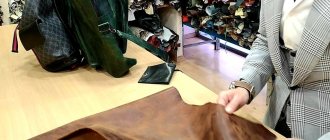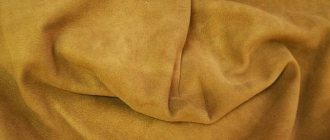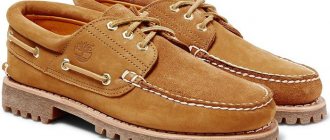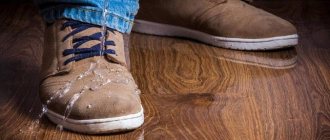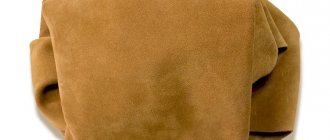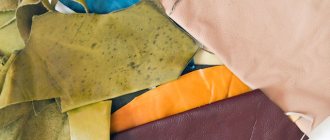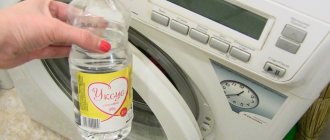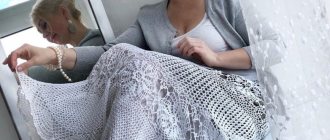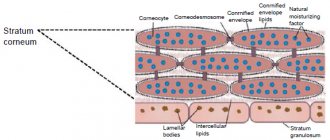Characteristics and properties of nubuck for shoes
The material owes many of its unique properties to the way it is processed. If fat and fat-formaldehyde compounds are used to tan suede, nubuk is treated with mineral salts, often chrome salts. As a result of such tanning, the leather becomes more pliable and wear-resistant, but at the same time capricious. Products made from it are tensile-resistant and have excellent shock resistance.
Some characteristics of nubuck are similar to aniline leather.
- Nubuck is very soft to the touch
- Nubuck leather is very sensitive and scratches easily
- Drops of water temporarily darken the skin, but after drying it returns to its original color
Genuine Leather
What is nubuck leather? After treatment with salts and sand, the natural base becomes soft, slightly fleecy, pleasant to the touch, and breathable. It is often used in the furniture industry. Italian craftsmen appreciated the tactile properties of the fabric; furniture made from it is in demand and expensive. Almost no shoes are made from such a base - only sandals, because it:
- more decorative than practical;
- does not withstand difficult climatic conditions;
- It is not very resistant to stains and is difficult to clean.
- Permanent eyebrow makeup hair technique
- Strengthening nails with acrylic powder for gel polish step by step
- Pinched nerve in the lower back
Kinds
Nubuck comes in several types, and each of them has its own characteristics.
- Natural is a material tanned from the skin of cattle. For dressing, chrome salt is used, after which the face is treated with fine materials. This can be sand or sandpaper.
The material has a delicate velvety surface and small pile. It is airtight and does not require much maintenance. However, it is not wear-resistant and must be regularly treated with antiseptics and special products. It has more of a decorative function than a practical one. More often used for upholstery of upholstered furniture - sofas, armchairs, etc.
- Artificial nubuck is made from synthetic raw materials by alternately spraying several layers of polymers. Externally, this material is actually similar to the natural version, only it is hydrophobic and does not allow air to pass through. And although shoes made of this material perfectly protect against rain, your feet will sweat in them.
- Oil (oiled) is of natural origin. The material undergoes special additional treatment to remove moisture: during manufacturing, it is impregnated with a composition of various oils. As a result, not only does its wear resistance increase, but the greased nubuck acquires not a velvety feel, but an external dampness. Here's what it looks like:
Why is nubuck preferable to velvet or suede?
The main reason why nubuck is preferred over velvet, suede or synthetic materials is durability. Manufacturers of velvet shoes and other clothing using velvet tend to have problems sewing the material, leading many to use polyester corduroy as an alternative.
However, with synthetics, the authenticity of the product is lost and the risk of poor workmanship increases. Nubuck shoes are made from cattle leather, producing a thicker fabric than velvet, allowing the manufacturer to control the production of shoes, wallets and the rest without the typical durability issues that weaker materials present.
The top portion of the animal's hide is sanded to remove any imperfections that may be on the skin. And in “traditional” leather, this step is performed as desired, in an attempt to imitate suede or velvet.
Softer material than "traditional" leather
When you think of leather goods, the first things that come to mind are Italian shoes, wallets and belts. And while these products definitively dominate traditional leather, they are not representative of leather's versatility, especially when it comes to nubuck. The traditional material has a very rough texture, which is necessary for wallets and items that will be constantly folded and unfolded.
For example, nubuck shoes do not require the same thickness of leather. The result is a level of flexibility for the user that doesn't strain the stitching or detract from the overall design.
What is nubuck made from?
According to Wikipedia, “Nubuck is similar to suede, but is made from other types of leather, usually from cattle.” Here the added thickness affects the layer level and not the overall product.
In traditional leather, the animal hide is not sanded and is used with all its rough edges. For leather to be usable, it must be multi-layered (thus it will be in a thicker state). Nubuck is thicker and requires fewer layers. Therefore, when the overall layer is thicker, the overall product tends to be thinner.
What is nubuck in comparison with mass material, its pros and cons
In addition to the durability mentioned earlier, synthetic materials present several problems for the buyer. Of course, there are nubuck shoe suppliers who mass produce them, but there are many local manufacturers who also offer quality products.
According to Forbes, non-mass-produced products can have more consistent results by creating one perfect unit at a time. Joanne Mueller, Forbes Contributor
And while the Forbes article focused on single-cavity presses versus mass sewing methods, it's safe to conclude that similar results can be found in machines that must cut, glue, squeeze, embroider and mold (since most shoes have rubber soles) - they will have a higher level of nonconformity in mass production than in one-off production. The fact is that synthetic materials are usually used in mass production, and not at the private level. The reason is that the materials are sold in bulk (both in the size of the material rolls and in quality), which is not ideal for a local leather manufacturer.
Read about: batting is a material that knows its place
Nubuck is considered a high-quality or luxury leather. This in itself puts the product above quality leather. However, the added value is demonstrated by the added elasticity of the upper leather and the versatility of its use.
Flaws
Nubuck leather shoes tend to be a little more susceptible to water damage than "traditional" leather. As with any leather product, water can cause the material to first expand (as leather is an absorbent material) and then overcompensate by contracting as it dries. This puts stress on the adhesive, seams and other areas of the shoe. It is also prone to cracking and tearing if not regularly maintained.
- Besides water damage, buyers should be aware that nubuck is a little more susceptible to staining than regular leather.
- As the pores open up a little more and polish is applied to the surface, any stains or dirt that comes into contact with the boot should be cleaned off immediately.
- The surface of the nubuck also needs to be dyed to begin with, so any dyes that accidentally spill (like wine or other such stains that tend to have permanent effects) become more difficult to remove.
Advantages and disadvantages
Compared to its analogues, nubuck has a number of positive features:
- "breathes". The ability to pass air does not affect the heat preservation function;
- strength. Withstands increased load, mechanical damage, frost;
- stretching “Stretchability” allows you to give the fabric a given shape;
- wide color palette. Easily painted in any shade;
- suitable for making all-season footwear from warm winter boots to light summer ballet shoes;
- looks impressive and expensive.
The undoubted advantage is the price. This criterion makes the paintings in demand.
Along with its advantages, nubuck has several features that must be taken into account before purchasing a product:
- sensitivity to high humidity. Things are durable only after water-repellent treatment. If you neglect this point, you may encounter a number of problems. The structure of the canvas changes and loses its quality characteristics. When kept in liquid for a long time, it becomes deformed;
- labor-intensive care. To maintain the original appearance, the owner will have to clean the shoes daily with special products;
- low practicality. The nubuck material is easily soiled, so most users try to wear things for a “special occasion” and do not wear them in rain or snow;
- gradual loss of color. Bright shades fade, pale ones “burn out” completely. This is due to frequent cleanings. The problem can be solved by using care creams and sprays with the addition of an identical dye;
- possibility of rubbing. Hard material does not tolerate oiling, so you will have to break it in naturally.
Author:
Zakharova Nina Afanasyevna
I hope you like my article! If you find any shortcomings, just write to me about it! I am always ready for a conversation and will answer any questions you have, ask them!
